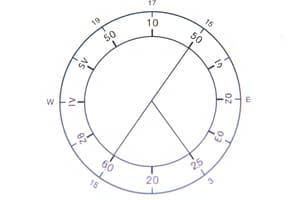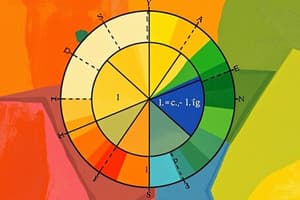Podcast
Questions and Answers
What is the definition of a Unit Circle?
What is the definition of a Unit Circle?
- A circle with variable radius
- A circle centered at any point on the plane
- A circle whose center is at the origin and has a radius of one (correct)
- A circle with a radius of two
How do you read Unit Circle coordinates?
How do you read Unit Circle coordinates?
(x,y)=(cos,sin)
An angle is formed by two rays with the same endpoint and makes an _______.
An angle is formed by two rays with the same endpoint and makes an _______.
angle
What are coterminal angles?
What are coterminal angles?
Match Degrees with their equivalent in Radians.
Match Degrees with their equivalent in Radians.
How do you convert from Degrees to Radians?
How do you convert from Degrees to Radians?
How do you convert from Radians to Degrees?
How do you convert from Radians to Degrees?
What is the formula for sin(0)?
What is the formula for sin(0)?
What is the formula for csc(0)?
What is the formula for csc(0)?
What is the formula for cos(0)?
What is the formula for cos(0)?
What is the formula for sec(0)?
What is the formula for sec(0)?
What is the formula for tan(0)?
What is the formula for tan(0)?
What is the formula for cot(0)?
What is the formula for cot(0)?
What does SOH CAH TOA stand for in Trigonometry?
What does SOH CAH TOA stand for in Trigonometry?
What is a Reference Angle?
What is a Reference Angle?
What does the equation y = sin(x) represent in graphing trig equations?
What does the equation y = sin(x) represent in graphing trig equations?
What is the goal for changing the period of a trigonometric function?
What is the goal for changing the period of a trigonometric function?
What is Phase Shift in trigonometry?
What is Phase Shift in trigonometry?
What are Trig Identities?
What are Trig Identities?
What is the method for verifying trig equations?
What is the method for verifying trig equations?
How do you solve trig equations?
How do you solve trig equations?
The tangent value for (1/2, 3/2) is _______.
The tangent value for (1/2, 3/2) is _______.
The tangent value for (2/2, 2/2) is _______.
The tangent value for (2/2, 2/2) is _______.
The tangent value for (3/2, 1/2) is _______.
The tangent value for (3/2, 1/2) is _______.
In which quadrants are tangent values positive?
In which quadrants are tangent values positive?
In which quadrants are tangent values negative?
In which quadrants are tangent values negative?
Flashcards are hidden until you start studying
Study Notes
Unit Circle
- Centered at the origin with a radius of one, providing key coordinates for trigonometric functions.
Unit Circle Coordinates
- Coordinates represented as (x,y) correspond to (cos, sin) for angle measurement.
Angles
- Formed by two rays sharing a common endpoint.
Coterminal Angles
- Share the same terminal side in standard position; can be found by adding or subtracting 360° for degrees or 2π for radians.
Degrees and Radians
- Degrees represented as decimals, while radians as fractions.
Conversion from Degrees to Radians
- Multiply degrees by π/180 to convert to radians.
Conversion from Radians to Degrees
- Multiply radians by 180/π to convert to degrees.
Sine and Cosecant Relations
- sin(θ) = y/r and csc(θ) = r/y, establishing the relationship between sine and cosecant.
Cosine and Secant Relations
- cos(θ) = x/r and sec(θ) = r/x, linking cosine with secant.
Tangent and Cotangent Relations
- tan(θ) = y/x and cot(θ) = x/y, demonstrating the connection between tangent and cotangent.
Trigonometry Basics
- Remember the mnemonic SOH CAH TOA for defining sine, cosine, and tangent.
Reference Angle
- The acute angle formed between the terminal side of an angle and the horizontal axis, crucial for evaluating trigonometric functions.
Graphing Trigonometric Equations
- For y=sin(x), observe the y-values; for y=cos(x), focus on the x-values; for y=tan(x), calculate by dividing y-value by x-value.
Changing Trigonometric Function Periods
- Adjustments can be made through the equation y=cos(1/2 θ), where the original period is doubled.
Phase Shift
- Refers to the horizontal movement of a trigonometric function, expressed in equations like y=cos(x - c).
Order of Operations for Equations
- Follow proper sequence in equations such as y= -2sin(1/2 (x - d)).
Trigonometric Identities
- Key identities include:
- sin²(θ) + cos²(θ) = 1
- tan(θ) = sin(θ)/cos(θ)
- Derivations leading to single value outcomes.
Key Sine and Cosine Values
- sin(90°)=1; sin(-90°)=-1; sin(30°)=1/2; cos(60°)=1/2.
- Notable angles yield significant sine and cosine values.
Co-Function Identities
- Not explicitly defined in the notes but pertain to the relationships between angles.
Negative Angle Identities
- Identifying behavior of trigonometric functions under negative angles:
- sin(-x) = -sin(x)
- cos(-x) = cos(x)
- tan(-x) = -tan(x)
Verifying Trigonometric Equations
- For verification, manipulate one side of an equation using trigonometric identities to match the other side.
Solving Trigonometric Equations
- Tackle like linear equations, isolating trig functions (sin(x), cos(x), tan(x)) on one side of the equation.
Tangent Values
- Understand tangent values in reference to the unit circle:
- (1/2, 3/2) yields 3; (2/2, 2/2) yields 1; (3/2, 1/2) yields 3/3.
- Positive values occur in quadrants 1 and 3, while negative values are found in quadrants 2 and 4.
Studying That Suits You
Use AI to generate personalized quizzes and flashcards to suit your learning preferences.




